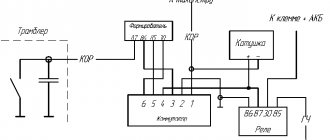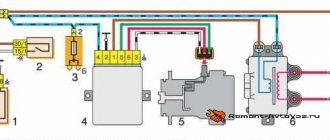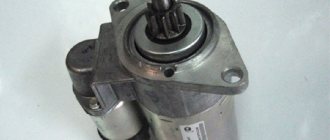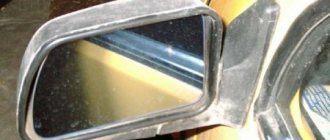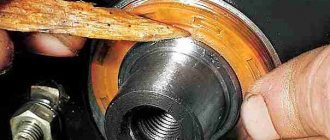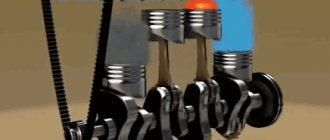In 1989, car enthusiasts saw the first copies of the VAZ 1111, which became the basis for the family. Three factories mastered the production of small cars: VAZ in Togliatti, KamAZ in Naberezhnye Chelny, Serpukhov, whose car plant specialized in the production of motorized wheelchairs for the disabled. This distribution of forces and resources made it possible to quickly begin production of this model without the construction of new production facilities.
Buyers were offered two versions of the car, which differed only in the power unit. The car has front-wheel drive, and replacing the Oka timing belt is carried out by analogy with VAZ 2108 and VAZ 21083 engines.
About the engine
For these models, engines 2108 and 21083 were taken as the basis. They are 2-cylinder engines with an in-line vertical arrangement of cylinders. The camshaft is installed in the cylinder head. The working volume is 649 cm 3 and 749 cm 3. The increase in volume is obtained by increasing the diameter of the pistons from 76 mm to 82 mm. The cylinder blocks of these engines, heads, flywheels, and pulleys are different.
Many spare parts are unified with their 4-cylinder variants. The power supply system is carburetor, but with changed calibration data. In 1990, the timing belt on the power unit was replaced. If the previous product had semicircular teeth, then on the new one they began to have a trapezoidal shape with a groove at the top of the tooth. The pulleys were changed to match the tooth profile, but the belts themselves are interchangeable; you can use both new and old parts.
It is possible to obtain maximum efficiency from using an internal combustion engine only with the correct adjustment of the valve timing. There are marks on the timing drive for this purpose. One of them is the protrusion on the rear cover for the drive belt protection, which should coincide with the mark on the camshaft pulley. The second mark is located at the bottom of the cylinder block, and it coincides with the mark on the crankshaft pulley. The piston of the first cylinder should be at top dead center at this time.
Are the valves bending?
This question worries many owners, since after such an “incident” a costly overhaul of the power unit will follow. Mechanics know of cases where, after the pistons met the valves, in addition to bent valves, the piston heads were damaged and the guide bushings in the cylinder head were destroyed. The engine, based on the VAZ 21083 engine, is free from such shortcomings. The pistons of this internal combustion engine have recesses that prevent the valve head from meeting the upward-moving piston.
This problem can occur in two cases:
- Cutting teeth on the timing belt.
- The alignment marks on the engine being repaired are not aligned correctly.
To avoid this, you should carefully study the process of replacing the belt, or seek help from service center specialists.
Will the valves bend?
This question is sometimes almost the main one. Some motorists refuse to buy a car if the valves on the engine bend when the belt breaks. This is understandable, since after this you have to completely repair the cylinder head. And this pleasure is not very cheap. It must be said right away that on engines based on 21083, the valves do not bend. There are recesses at the top of the pistons that prevent them from hitting the valves (arrows point to them in the photo).
But on the 2108 motor there is a bending problem and it can arise in the following cases:
- If the teeth on the drive belt are cut off.
- If the marks on the shaft pulleys are set incorrectly.
To prevent breakage, you need to change the belt correctly. Any motorist who knows how to handle wrenches can replace the timing belt on the Oka.
Oka gas distribution mechanism
If you compare old VAZ classic engines with a timing chain drive, you will notice significant differences in the design of the drive. The bulky metal chain was replaced with a timing belt. The design of the cylinder block has become shorter and lighter, since the opening for the chain in the timing drive mechanism has disappeared. The designers changed the principle of opening valves, it became simpler. If on old engines the camshaft cam pressed on the valve stem through the rocker arm, now it acts on it through the adjusting washer. The thermal gap is set on a cold engine by selecting a washer of the required thickness. Manufacturers make them in different sizes, the values of which are marked on the ends of the washer. If the driver adjusts the thermal gap independently, he will have to purchase a certain number of such washers, which is not always economically feasible.
The design of the timing mechanism drive is such that the belt drives the pump in the Oka engine cooling system. Often it is because of the breakdown of this pump that the toothed belt drive fails. Therefore, car manufacturers recommend that the belt drive and pump in the engine cooling system be replaced at the same time. When inspecting, you should pay attention to the condition of the tension roller in the timing mechanism.
Belt replacement procedure
The process of replacing a timing belt on Oka is not very difficult. If you carefully study the process before doing this, you can do it yourself. The work can be done on any level surface.
Before starting the operation, install wheel chocks under the rear wheels and tighten the hand brake cable. The front wheels are turned to the right as far as possible (all the way), and the battery is disconnected. The further procedure will be something like this:
- In the engine compartment, remove the spare wheel and the windshield washer fluid reservoir. You will also have to dismantle the air filter housing and ignition coil.
- After loosening the tension on the generator set drive belt, remove it from the pulleys.
- After this, you can remove the protective plastic timing case.
- Next, rotate the crankshaft clockwise until all the timing marks in the timing drive are aligned.
- It is not yet possible to remove the toothed belt; the generator set drive pulley on the engine crankshaft is in the way. There is a hole on the right mudguard in the direction of travel of the car. A 19mm socket wrench is inserted into it to unscrew the bolt on the crankshaft pulley. Before doing this, you should secure the motor from turning. This can be done through a hole in the top of the flywheel housing by inserting a strong screwdriver or suitable pry bar between the flywheel teeth. An assistant should hold it.
- Unscrew the bolt securing the generator pulley and remove it from the shaft.
- Next, loosen the tension of the timing belt. To do this, you need a 17mm wrench to loosen the tension roller nut. If it is replaced, then completely remove it from the axle. There is an adjusting washer in front of the roller on the block side.
- If the pump in the engine cooling system is being replaced, drain the antifreeze and then remove it from the engine block.
- Remove the toothed belt. Important! The engine cannot be cranked after this, so as not to bend the valves.
- Carefully inspect the condition of the timing drive pulleys, clean them of possible contamination and traces of engine oil.
- Installing a new timing belt is done in the reverse order. Before this, carefully check once again how the timing marks in the timing drive mechanism match. At the end of the work, manually turn the engine several times, and again check how the marks match.
Replacement timing
The vehicle operation regulations recommend that owners check the condition of the belt drive and belt tension after a run of 30 thousand km (more often). It is recommended to replace it after 60 thousand km. If the car owner does not change the belt within this period, it may be destroyed.
It is not allowed to operate the Oka with traces of engine oil leaks in the area where the toothed belt operates. It has a bad effect on the belt material and accelerates its destruction. Engine oil leaks should be repaired and the toothed belt replaced with a new spare part. If you carry out maintenance work on the power unit in a timely manner and with high quality, then there will be no problems for the owner.
| You will need | |
| |
Disconnect the wire from the “–” terminal of the battery. Setting the piston of the first cylinder to the top dead center (TDC) position of the compression stroke is necessary so that when carrying out work related to removing the camshaft drive belt, the valve timing is not disturbed. Set TDC according to the marks on the camshaft timing pulley. When installed according to the marks on the flywheel, generator drive pulley or crankshaft toothed pulley, the piston of the 1st or 2nd cylinder may be in this position. Then be sure to make sure that the marks on the flywheel, or the generator drive pulley, or on the crankshaft sprocket (if the generator drive pulley is removed) match. If the marks on the flywheel or crankshaft pulley do not match, it means that the valve timing is incorrect (the piston of the 1st cylinder is not installed at TDC). In this case, it is necessary to remove the camshaft drive belt and rotate the crankshaft until the marks align.
Location of TDC marks
There is a protrusion on the camshaft timing pulley; There is a tendril on the rear cover of the camshaft drive belt.
There is a notch on the generator drive pulley; there is a long protrusion on the front camshaft cover (the generator drive belt has been removed). The short protrusion located nearby is a mark for setting the ignition timing.
There is a point on the crankshaft toothed pulley; There is a triangular cutout on the oil pump cover. These marks are visible only when the generator drive pulley is removed.
| On the flywheel - risk; on the scale of the crankshaft rear oil seal holder there is a middle cutout (it is necessary to remove the rubber plug). | |
| EXECUTION ORDER |
1.
Use a wheel wrench to turn the crankshaft by the bolt securing the generator drive pulley through the hole in the right wheel niche (to make it easier to turn the shaft, you can unscrew the spark plugs) so that.
2.
. The marks on the generator drive pulley and on the front camshaft drive cover (long mark) match.
3.
Remove the three bolts securing the front camshaft drive belt cover.
4.
Remove the bolts along with flat washers.
5.
Remove the front cover.
6.
Check the alignment of the marks on the camshaft pulley and the rear camshaft drive belt cover.
7.
If the mark on the pulley is on the opposite side of the mark on the rear cover, it means that the piston of the second cylinder is at TDC. Rotate the crankshaft one revolution.
Checking and adjusting the ignition timing of VAZ "OKA" 1111 1988-2008
Ignition timing is a very important parameter on which the normal operation of the engine depends. If this timing (ignition timing) is set incorrectly, the engine will start poorly, operate unstably at idle, not develop full power, overheat and consume gasoline unnecessarily. In addition, if the ignition timing is too large (“early” ignition), detonation may occur - a very dangerous phenomenon, often leading to emergency engine damage.
In a contactless ignition system, ignition timing (ignition timing) can only be set using a strobe light
A strobe light is available to almost every motorist, as it can be purchased at almost every auto parts store at an affordable price.
The ignition timing is checked and set at engine idle (at a crankshaft speed of 820–900 rpm). The angle should be within 1°± 1° BTDC.
Check the ignition timing using the mark on the flywheel and the scale of the crankshaft rear oil seal holder (the rubber plug has been removed). When the marks on the flywheel are combined with the middle division (notch) on the scale, the piston of the first cylinder is installed at TDC. One division on the scale corresponds to 2° of crankshaft rotation.
The ignition timing can also be checked and set using the marks on the generator drive pulley and the front camshaft drive belt cover. The long mark corresponds to the installation of the first cylinder at TDC, the short mark to the ignition advance by 5° of crankshaft rotation. These marks are used to set the ignition timing on the stand.
Replacing timing belt Lada 2114 (Lada (VAZ) 2114) in Moscow - compare prices
1. For ease of operation, remove the air filter (see “Removing and installing the air filter”).
2. Disconnect the hose from the vacuum regulator.
3. To check the ignition timing, connect the “+” clamp of the strobe to the “+” terminal of the battery, and the “ground” clamp of the strobe to the “–” terminal of the battery.
4. Remove the tip of the high-voltage wire from the spark plug of the first cylinder and connect it to the strobe sensor in accordance with the instructions included with the strobe.
5. Remove the rubber plug from the clutch housing hatch.
6. Start the engine and direct the flashing strobe light into the clutch housing hatch.
The stroboscopic effect is based on the inertia of human vision. With frequent alternation of bright flashes, the eyes see objects only at the moment of the flash. If the frequency of repetition of flashes coincides with the frequency of rotation of an object, this object appears motionless. When adjusting the ignition timing, the flywheel with a mark on it appears motionless.
Illuminated by strobe flashes, rotating engine parts (crankshaft and generator pulleys, cooling system radiator fan), as well as the generator drive belt, appear stationary or slowly moving. Be careful not to get injured.
7. When the ignition timing is correctly set, mark 1 on the flywheel should be between the middle division 2 and the previous division 3 of the scale. Otherwise, it is necessary to adjust the ignition timing.
When to change the timing belt according to regulations and expert advice?
8. To set the ignition timing, loosen the three nuts securing the spark timing sensor.
9. To increase the ignition timing, turn the sensor housing clockwise (the “+” mark on the flange of the sensor housing is towards the protrusion on the auxiliary drive housing. In this case, one division on the flange corresponds to 8° of crankshaft rotation). To reduce the ignition timing angle, turn the sensor housing counterclockwise (the “–” mark on the flange of the sensor housing is towards the protrusion on the auxiliary drive housing).
10. Tighten the sensor mounting nuts, check and, if necessary, repeat the ignition timing setting.
11. Connect the hose to the vacuum regulator.
Source
How to set timing marks on the oka
- Features of the timing device
The domestic car of the especially small class VAZ with the index 1111 (11113) is the only AvtoVAZ model from the entire family that was equipped with a two-cylinder engine. At the same time, during the creation of this motor, the designers tried to unify this motor as much as possible with other types, in particular from VAZ-2108-21099 cars. The result of this work was that the principle of operation of the units and many elements of these installations are the same and interchangeable (for example, CPG), the only difference is in quantity.
Design
The ignition system of the VAZ Oka consists of only seven main elements:
- Auxiliary relay;
- Egnition lock;
- Circuit breakers;
- Switch;
- Spark moment sensor;
- Coil;
- Candles;
All elements are connected to each other by wiring.
Using the ignition switch, the driver controls the power supply to the system from a source - the battery, while the voltage passes through the auxiliary relay and fuses. The lock has three positions - “0”, in which all electrical consumers are turned off, “1” - voltage is supplied to the ignition system and a number of other devices, and “2” - current is supplied to the starter. This switching sequence ensures that the ignition system is activated at the moment the engine starts.
Features of the timing device
The same applies to the gas distribution mechanism. The essence of the work is identical, as is the design, but the VAZ Oka has 11113 switchgear. the shaft has only 4 cams. Therefore, the maintenance of the power plant of a small car is no different from the VAZ-2108.
The Oka uses a gas distribution mechanism with an overhead camshaft, which is installed in the engine cylinder head. This made it possible to abandon a number of components (bars, rocker arms). In this design, the camshafts. shafts act on the valves through pushers. In this case, it is necessary to have a thermal gap between the component elements (cam-pushrod-valve heel), which compensates for the change in geometric parameters occurring due to expansion of the metal as a result of heating.
But during engine operation, wear occurs on the surfaces of the cams, pushers and heels as a result of friction, which causes the thermal gap to change. Moreover, it is not necessary that it will increase; it also happens that the gap decreases. This often happens due to low-quality oil, which leads to the appearance of deposits on the working surfaces of the timing belt.
As a result of a change in the thermal gap, a violation of the valve timing occurs, which is why the power plant loses power (which the Oka already has “sparsely”), fuel consumption increases, and dynamics decrease. And all because the valves either open insufficiently (increased clearance) or do not fit tightly to the seats (reduced clearance).
To compensate for changes in the thermal gap, the VAZ-1111 uses special adjusting washers, which are placed in a special seat in the pusher. That is, the contact of the camshaft cam occurs not with the pusher, but with the installed washer.
In order for the thermal gap to meet the standard, periodic adjustment of the valves on the Oka is required. Due to the design features of the timing belt, the entire process boils down to installing washers of the required thickness.
Springs
Springs (outer 16 and inner 17) press the valve to the seat and do not allow the valve pusher to come off the actuator. The lower ends of the springs rest on the support washer 18 springs. The upper support plate 15 of the valve springs is held on the valve stem by two valve nuts 14, which when folded have the shape of a truncated cone. The cotters have three internal flanges that fit into the corresponding recesses on the valve stems. This design provides both a reliable connection and the ability to rotate the valves during operation, so they wear more evenly.
When should adjustment be made?
The valve clearance on the Oka, according to the manufacturer’s recommendations, should be adjusted every 30 thousand km. But this is far from an accurate indicator, since much depends on operating conditions. Thus, lubricants, fuel, climatic conditions, features and intensity of use of the car can significantly affect the operation of the timing belt, and work on adjusting the thermal gap will have to be carried out earlier.
There are a number of signs indicating a change in the thermal gap:
- Increased engine noise (the sound of the unit is similar to a diesel unit);
- Power drop;
- Poor launch;
Some note that fuel consumption also increases. This is true, but the Oka uses a carburetor power system (except for the latest models equipped with a Chinese 3-cylinder unit), so it is simply unrealistic to determine the amount of fuel consumed, and such a sign of a change in the thermal gap can be ignored.
This type of maintenance can be done with your own hands, since the whole process is not complicated, but you need to know how to properly adjust the valves on the Oka.
The main thing you need to know is what valve clearance on the Oka is considered normal. Here it all depends on what kind of valve it is: for the intake valve it is 0.2 mm (an error of 0.05 mm is allowed), and for the exhaust valve it is 0.35 mm (the same error).
Malfunctions
The simplified design of the ignition system and the absence of moving components ensures high reliability and ease of maintenance.
There are not so many malfunctions in the Oka ignition system:
- Switch failure;
- Hall sensor malfunction;
- Coil failure;
- Breakage or breakdown of wires, oxidation of contacts;
- Spark plug malfunction;
- Violation of the ignition timing;
Since the ignition system is directly involved in the operation of the engine, any malfunction in it immediately affects the performance of the engine - interruptions occur, the unit does not develop power, popping noises appear, or the unit simply does not start.
Diagnosis of a malfunction is carried out by visual inspection of the wiring and its connections, as well as by sequentially replacing all components with known good ones. A check using measuring instruments allows you to more accurately determine the faulty element.
The search for the problematic element is carried out from the candles. That is, first the presence of a spark is checked on them, then the high-voltage wires are inspected, and then the performance of the coil, switch, and Hall sensor is diagnosed.
The components of the ignition system are non-repairable, so if they break down they must be replaced.
What will you need?
The only problem with timing belt adjustment is the shims. The fact is that a professional set of them is quite expensive, since it includes washers with a thickness of 3.0 to 4.5 mm (in increments of only 0.05 mm).
But many auto stores sell these washers separately, so the price of one washer is low. Only in the process of carrying out the work will you have to make all the necessary calculations, go to the auto store, purchase the required sized elements and download the assembly.
In addition, you will also need special devices - a tool for squeezing the valve and retainer. Since this specialized tool is practically not found on Oka, you can buy a regular one - for the VAZ-2108, and modify it a little.
The squeeze tool consists of a tube with holes for attaching to the valve cover studs, and a handle with a curved lever (pointed at the end) connected through an axle, allowing the lever to move freely.
The tool works simply: a handle with a lever is put on the tube. It is then secured to the valve cover studs. The handle moves freely along the tube, allowing it to be positioned exactly opposite the cam. The lever is installed between the cam and the pusher; when you press the handle, it compresses the valve spring, and all that remains is to install a clamp to hold the pusher in the depressed position. You can see how everything happens in the photo below.
As for modifying the tool from the VAZ-2108 to work with the VAZ-11113, you just need to drill two through holes in the tube, the distance between which corresponds to the position of the valve cover studs of the Oka engine (it is 17.8 cm).
In general, to make the adjustment you will need:
- Set of keys (open-end, socket);
- Screwdrivers;
- Punch and tweezers;
- Tool for squeezing pushers;
- Retainer;
- Set of probes;
- A tool for accurately measuring thickness (at least a caliper);
- Washers;
- Rags;
- New valve cover gasket;
Sequencing
All work is performed on a cold engine. The whole process is done like this:
Remove the air filter housing from the car. Cover the carburetor with a rag;
We disconnect the pipes from the valve cover and move them to the side;
Unscrew the nuts securing the valve cover and remove it;
We set the TDC. To do this, rotate the crankshaft until the marks on the generator drive pulley and the timing belt cover align (since there are two marks on the cover, you need to install it on the long one);
The order of adjustment of the cylinders on the Oka is not important, since in the engine of this car they run synchronously. That is, start adjusting on any cylinder
It is only important to remember that the outer valves are exhaust, and the inner ones are inlet (exhaust-inlet-inlet-exhaust). This is necessary in order not to confuse the thermal gaps
For example, we will consider a cylinder located closer to the camshaft gear;
We measure the gaps on the valves of the selected cylinder using feeler gauges and write them down;
The pushers have special slots for removing the washer. Use a screwdriver to turn the pusher to turn one of the slots towards you;
We install a squeezing tool on the valve cover studs and secure it with nuts;
We place the handle opposite the first valve, place the lever between the camshaft. shaft and pusher, press the handle, overcoming the force of the spring;
Install the retainer between the distributors. using the pusher shaft, remove the lever and move it to the side;
Use a punch to pry up the washer, and then remove it with tweezers;
The washer has its size marked on it (if it is worn, we change its thickness with a caliper);
We calculate the required thickness of the new washer. To do this, take the thickness of the removed washer, add the measured thermal gap to the value and subtract the nominal value. Let's take the intake valve as an example. The measured gap was 0.28 mm. We removed the washer, measured it and got a value of 3.80 mm. We combine these indicators - 4.08 mm. We subtract the nominal gap (0.2 mm) from it and it turns out that you need to install a washer 3.88 mm thick. Since there is no element with this value in the set, we select the closest one to it (for this we need an error of 0.05 mm). As a result, to restore the thermal gap, a washer with a thickness of 3.90 mm is needed.
We install the selected washer and move on to the next cylinder valve. We calculate the thickness in the same way, but taking into account the fact that the exhaust valve has a nominal gap of 0.35 mm;
After making adjustments on one cylinder, move on to the other. But to do this, it is tedious to rotate the crankshaft 360 degrees. And then all work is performed in the same way as indicated above;
After adjustment, we install the removed elements from the engine, and the valve cover gasket must be replaced;
Finally, we note that this operation is also carried out in the case of work related to the removal of the camshaft, for example, when replacing valve seals.
Article on the topic - Adjusting the valves of the VAZ "Classic"
Timing belt
The timing belt is quite an important element of any car. Thanks to it, the operation of the camshaft and crankshaft is synchronized in all vehicle engines. Due to the material used, the operation of the timing belt is almost silent, and it is not susceptible to any corrosion processes.
Due to the low cost of rubber, the price of the belt is relatively low. Any car owner can buy a timing belt online or in specialized stores. The cost of a belt depends on its manufacturer and quality.
There is both an original Oka timing belt with article number 11116, and analogues that are in no way inferior in quality to the original.
| Name | vendor code | Cost in rubles |
| Timing belt - VAZ 2108/09, OKA | BD111R | 400 |
| Timing belt VAZ-2108-099, set with roller GATES | K015521 | 1200 |
| Timing belt VAZ-2108-09 | 2108-1006040-10RU | 450 |
| Timing belt VAZ 1111 OKA | BD111 | 350 |
The task of the timing belt is to provide the necessary operating parameters of the gas distribution system. During the production process, all products undergo mandatory quality control, since a broken belt leads to very sad consequences. This is fraught with long and expensive repairs to the car engine. The combination of materials used for the production of belts allows you to increase them:
- wear resistance;
- elasticity;
- reliability of transmitted torque;
Western manufacturing companies have launched the production of reinforced belts that can operate under heavy loads. This reduces the risk of belt damage, and therefore increases the period of operation without replacement.
Each type of engine has its own characteristics, and therefore timing belts differ in the following parameters:
The belt's high-strength polyester reinforced with spirally laid fiber optics increases its ability to maintain stable tension even under increased loads. At the same time, the length of the belt is completely preserved.
The mechanism of gas distribution of an OKA car
Maximum engine efficiency can be achieved only by correctly adjusting the valve timing. This is largely facilitated by the timing marks marked on the drive. The first of them, in the form of a protrusion, is located on the cover of the drive belt protective cover. It should coincide completely with the one located on the crankshaft pulley. The second mark is located at the bottom of the cylinder block and must also coincide with the mark on the crankshaft. When setting the marks, the cylinder piston must be at the top point (TDC).
If you compare old VAZ model engines that have a chain timing drive, which is bulky and noisy, it is not difficult to notice very significant differences. The bulky chain is replaced by a timing belt. The design of the block has changed a lot; it has become shorter and lighter. The opening of the valves has also changed, the principle has become simpler.
Structurally, the drive is designed so that it operates a pump that pumps engine coolant. Often, due to damage to the pump, the belt breaks, so designers recommend that when changing the timing belt, if possible, also replace the cooling system pump. This will avoid many further problems. You also need to inspect the tension roller; you may have to change it too.
Timing Belt Replacement Procedure
The procedure for replacing the timing belt on an Oka car cannot be called too complicated. If you carefully study the instructions and follow its instructions exactly, you can even replace the belt yourself.
When starting work, the car is put on the handbrake, the rear wheels are secured with shoes. The next procedure will be as follows:
- Remove the spare wheel and windshield washer reservoir from the engine compartment. Disconnect the battery and remove the air filter, as well as the ignition coil.
- After loosening the generator drive belt, remove it completely.
- Then the timing drive protective cover is dismantled.
- Rotate the crankshaft clockwise until the timing marks align.
- Then remove the generator pulley, which is located on the engine crankshaft.
- Unscrew the bolt securing the generator pulley and dismantle it.
- The belt tension is weakened. The next thing to loosen is the nut that secures the tension roller. If it is planned to replace it, then it will also be dismantled.
- If the cooling system pump is replaced, the coolant is drained. After this, the pump is also dismantled.
- Next, the timing belt is removed. Very important! After removing the belt, do not turn the engine under any circumstances, so as not to bend the valves.
- A thorough inspection of the timing pulleys is carried out, they are thoroughly cleaned of dirt and traces of oil.
- After replacing the timing belt, installation is carried out in the reverse order. The main thing is not to forget to check that the timing marks match.
Setting the advance angle
Setting the ignition timing is the only operation that is performed in the ignition system.
A strobe light is used to set the angle correctly. The technology for performing the work is not complicated. The algorithm of actions is as follows:
- We connect the strobe to the power source and the tip of the spark plug of the 1st cylinder (according to the instructions for the device);
- Remove the plug from the inspection window on the clutch housing;
- We start the engine (it should be idling);
- We direct the beam of light from the strobe into the viewing window;
- We determine the position of the marks (with the angle correctly set, the mark on the flywheel at the moment the strobe light beam flashes should be located between the central and rear marks on the crankcase);
- If the marks are not positioned correctly, make adjustments. To do this, loosen the bolts securing the spark moment sensor and rotating it around its axis until the marks match;
After adjustment, tighten the sensor fasteners, turn off the engine, disconnect the strobe light and replace the plug.
Timing for replacing timing belt
According to the regulations, car owners are recommended to check the condition of the timing belt, as well as its tension, every 30 thousand km. It is recommended to replace the belt, despite its condition, after a mileage of 60-70 thousand km. If you do not change the belt in time, it may break, and this, as mentioned earlier, threatens very serious damage to the engine, and therefore expensive repairs.
It is strictly prohibited to operate an OKA vehicle if even the slightest traces of oil are found on the surface of the timing belt. The leak must be identified and repaired immediately, and the belt must be replaced. If the timing mechanism is serviced on time and efficiently, then the car owner should not have any problems. If you follow all the tips given in this article, replacing the belt will seem like the simplest action possible.

